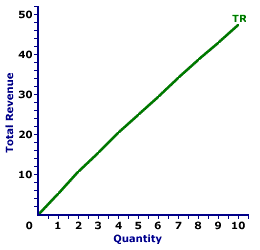
|
|
PPC: The abbreviation for production possibilities curve, which is a curve that illustrates the production possibilities for the economy. A production possibilities curve represents the boundary or frontier of the economy's production capabilities. That's why it's also frequently termed a production possibilities frontier (or PPF). As a frontier, it is the maximum production possible given existing (fixed) resources and technology. Producing on the curve means resources are fully employed, while producing inside the curve means resources are unemployed. The law of increasing opportunity cost is what gives the curve its distinctive convex shape.
Visit the GLOSS*arama
|
|


|

|
                           TOTAL REVENUE CURVE, MONOPOLISTIC COMPETITION: A curve that graphically represents the relation between the total revenue received by a monopolistically competitive firm for selling its output and the quantity of output sold. It is combined with the total cost curve to determine economic profit and the profit maximizing level of production. The slope of the total revenue curve is marginal revenue. Monopolistic competition is a market structure with a large number of relatively small firms that sell similar but not identical products. Each firm is small relative to the overall size of the market such that it has some market control, but not much. In other words, it can sell a wide range of output at a narrow range of prices. This translates into a relatively elastic demand curve. If a monopolistically competitive firm wants to sell a larger quantity, then it must lower the price.The total revenue curve reflects the degree of market control held by a firm. For a perfectly competitive firm with no market control, the total revenue curve is a straight line. For firms with more market control, such as monopolistic competition, the slope of the total revenue curve flattens at larger quantities. The slope of this total revenue curve is marginal revenue. Total Revenue Curve,
Sandwich Style |  |
The total revenue curve for Manny Mustard's House of Sandwich is displayed in the exhibit to the right. Key to this curve is that Manny Mustard is a monopolistically competitive provider of Deluxe Club Sandwiches and thus faces a negatively-sloped demand curve. Larger quantities of output are only possible with lower prices.The vertical axis measures total revenue and the horizontal axis measures the quantity of output (number of sandwiches). Although quantity on this particular graph stops at 10 sandwiches of medicine, it could go higher. This curve indicates that if Manny Mustard's House of Sandwich sells 1 sandwich (at $5.25 per sandwich), then it receives $5.25 of total revenue. Alternatively, if it sells 10 sandwiches (at $4.75 per sandwich), then it receives $47.50 of total revenue. While the curvature is slight, the total revenue curve for monopolistic competition is not a straight line. While the curvature is slight, the total revenue curve for monopolistic competition is not a straight line. For Manny Mustard the total revenue curve has a slightly flatter slope as more output is produced. The changing slope of this curve is due to the changing price.

Recommended Citation:TOTAL REVENUE CURVE, MONOPOLISTIC COMPETITION, AmosWEB Encyclonomic WEB*pedia, http://www.AmosWEB.com, AmosWEB LLC, 2000-2025. [Accessed: July 18, 2025].
Check Out These Related Terms... | | | | | | | | |
Or For A Little Background... | | | | | | | | |
And For Further Study... | | | | | | | |
Related Websites (Will Open in New Window)... | | | |
Search Again?
Back to the WEB*pedia
|



|

|
BROWN PRAGMATOX
[What's This?]
Today, you are likely to spend a great deal of time browsing through a long list of dot com websites seeking to buy either a case of blank recordable DVDs or a pair of red goulashes with shiny buckles. Be on the lookout for mail order catalogs with hidden messages.
Your Complete Scope
This isn't me! What am I?
|

|
|
Parker Brothers, the folks who produce the Monopoly board game, prints more Monopoly money each year than real currency printed by the U.S. government.
|

|
|
"A winner is someone who recognizes his God-given talents, works his tail off to develop them into skills, and uses those skills to accomplish his goals. " -- Larry Bird, basketball player
|

|
NNP
Net National Product
|

|
|
Tell us what you think about AmosWEB. Like what you see? Have suggestions for improvements? Let us know. Click the User Feedback link.
User Feedback
|


|


